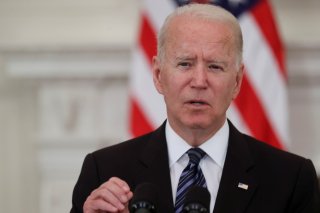It’s Time to Treat Gun Violence like the National Security Threat It Is
At a time when the Pentagon is spending record amounts on defense and security, why are hundreds of Americans a day lost to a preventable threat like gun violence?
With firearm injuries and deaths at a record high even with most of the country in lockdown all year, it’s time to start treating gun violence like the national security threat and foreign policy issue it is.
Early last year, a uniquely American consensus arose: the silver lining to a pandemic shutting down the country is that at least fewer people will die in mass shootings because children can’t get shot at school. The only thing more disturbingly dystopian than this line of thought surfacing is that it didn’t even end up being true. We saw 610 mass shootings in 2020, nearly 200 more than in 2019. Overall, 2020 was the deadliest gun violence year in the United States in at least two decades, and 2021 is looking worse already.
As America begins to re-open, we can’t allow a shift from one deadly pandemic back to another. Now is the time for a reckoning of the United States' approach to gun violence. More importantly, now is the time to ask ourselves what “national security” really means.
At a time when the Pentagon is spending record amounts on defense and security—more than China, India, Russia, the UK, Saudi Arabia, Germany, France, Japan, South Korea, Italy, and Australia combined—we should feel safer than ever. But with a quick glance at headlines, however, we quickly spot symptoms of an unsafe people. Last weekend, eight-year-old Faris Nunn was interviewed after a shooting outside Washington D.C.’s Nationals Park that left three people dead. "It was my 2nd shooting, so I was kind of prepared,” she said, “I’m always expecting something to happen."
Clearly, America is getting less secure for its people despite steadily rising spending on military and police. Crossing over into America’s borders makes you one thousand times more likely to get shot than in some other countries, and gun violence directly accounts for at least three of the top fifty-nine causes of death for Americans. Not to mention, gun violence greatly exacerbates issues like suicide, violence against women, right-wing extremist violence, and disproportionately affects Black and Latino men.
So, why isn’t gun violence in America treated as a domestic security threat, alongside issues viewed as official threats to the nation by Homeland Security like election security, transportation security, and the entire subject of “citizenship and immigration?” To start with, the United States' approach to gun violence values money over lives, catering to corporations in the business of maintaining political power and making money off of gun violence rather than catering to the safety of the American people.
For the past two decades, there has been no federal funding allocated for gun violence and injury prevention. This is thanks to the National Rifle Association (NRA), who successfully lobbied to remove funding for firearm research from the Centers for Disease Control (CDC)—and eventually, the National Institutes of Health (NIH)—after a study in 1993 found that keeping a gun in the home increases the risk of homicide. This chilling funding freeze has created massive gaps in our understanding of gun violence and has discouraged the next generation of researchers in the field. The severe lack of funding recently ended in 2020 with a $25 million grant to the CDC and NIH, opening the door to previously undiscovered knowledge on the issue. With public pressure, new research could inform new legislation that has the opportunity to save lives from gun violence.
We only need so much new federal research, however, to convince legislators that gun violence is indeed a severe threat to Americans. The real freeze is the government’s unwillingness to use our pre-existing national security guidelines and mobilize our resources to address the threat.
Being bold—or simply honest—enough to stop ignoring the United States’ security issue domestically will also prompt a reckoning with our foreign policy, starting with our role in gun violence abroad.
Over half of the world’s gun-related deaths come from six countries that make up less than ten percent of the world’s population: Brazil, the United States, Mexico, Colombia, Venezuela and Guatemala. The United States has played a key role in providing weapons and sustaining the organized drug trade that accounts for overwhelming amounts of illegal gun use in these countries. Our lax gun laws allow American firepower to fuel the disproportionate gun violence terrorizing parts of Central America. Seventy percent of firearms seized in Mexico and twenty-nine percent seized in Guatemala originated in the United States. Close behind the priority of American citizens’ security should be Biden’s own foreign policy promise to advance human rights and restore “moral leadership.” Stopping the steady flow of U.S. weapons to drug cartels in Central America would be a good place to start.
America’s failure to prioritize real safety for its citizens at home and people abroad is unsurprising but unacceptable. If the hundreds of Americans lost to gun violence each day were killed by any other preventable threat, or by some scapegoat-able foreign entity, there would be no delay in acting. Somehow, when the threat comes from within, we sit idly by while eight-year-olds get retraumatized while experiencing their second shooting. How many more will we let them endure?
Sofia Hines is a member of the Center for International Policy’s Summer 2021 Development and Communications Team.
Image: Reuters

